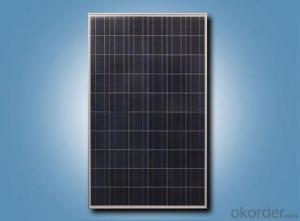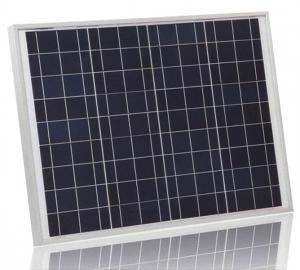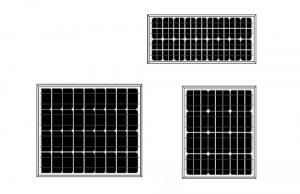36V Monocrystalline Solar Panel 165W with TUV Certificate
- Loading Port:
- China main port
- Payment Terms:
- TT OR LC
- Min Order Qty:
- 4290 watt
- Supply Capability:
- 2000000 watt/month
OKorder Service Pledge
OKorder Financial Service
You Might Also Like
36V Mono Solar Panel 165W with TUV Certificate
Features for monocrystalline solar panel :
1. Max Power Poly Solar Panel 310W and Mono Solar Panel 335W ;
2. Type of Connector : Compatiable Type MC4 ;
3. No. of Draining Holes in Frame : 16
4. High Transmission ,Low Iron and 3.2mm Tempered Glass ;
5. EVA Encapsuiation ;
6. White Tedlar Back side ;
7. IP65 Rated Junction Box ;
8.Clear Anodized Aluminum Alloy Type 6063T5 Frame ;
monocrystalline solar panel picture :
Quality and Safety for monocrystalline solar panel :
1. ndustry leading power output warranty, 25 year 80%, 10 year 90% power warranty and 10 year product warranty
2. ISO9001:2008 (Quality Management system) certified factory
3.Product Quality warranty & products Liability Insurance to guarantee and user' benefits
Picture details for monocrystalline solar panel :




Packaging & Shipping
Packageing Configuration : 26pcs / Box
Quantity Pallet : 1 box / Pallet
Loading Capacity : 812pcs/ 40'HQ
FAQ:
①what price for each watt?
it depends on the quantity, delivery date and payment terms,
②what is your size for each module? can you tell me the parameter of your module?
we have different series of panels in different output, both c-si and a-si. please take the specification sheet for your reference.
③Can you provide the peripheral products of the solar panels, such as the battery, controller, and inverter? If so, can you tell me how do they match each other?
Yes, we can, we have two companies for solar region, one is CNBM International, the other is CNBM engineering Co.
We can provide you not only the solar module but also Solar Cells, the off grid solar system, we can also provide you service with on grid plant.
④What is your warranty system?
Our product performance guarantees for 25 years
• 12 years guarantee for workmanship
• Timeliness of delivery
• Quality Products certified (TÜV, UL, CE, ISO)
⑥ Can you do OEM for us?
Yes, we can.
- Q: Can solar panels be installed on a factory or manufacturing plant?
- Yes, solar panels can be installed on a factory or manufacturing plant. In fact, many industrial facilities are increasingly adopting solar energy to meet their power needs and reduce their carbon footprint. The large roof areas and open spaces available in factories make them ideal locations for solar panel installations, enabling businesses to generate clean and renewable energy on-site while saving on electricity costs.
- Q: Can solar panels be used for powering a manufacturing facility?
- Yes, solar panels can be used to power a manufacturing facility. Solar energy can be converted into electricity, which can then be used to power various processes and equipment in a manufacturing facility. This can help reduce reliance on traditional energy sources and promote sustainability. However, the feasibility and capacity of solar power for a manufacturing facility would depend on factors such as the facility's energy requirements, available space for solar panel installation, and local sunlight conditions.
- Q: How do solar panels affect the aesthetics of a building?
- Solar panels can have both positive and negative effects on the aesthetics of a building. On one hand, they can enhance the visual appeal by adding a futuristic and environmentally friendly look. The sleek design of modern solar panels can be seen as an architectural statement, especially when integrated seamlessly into the building's design. On the other hand, some people may find the appearance of solar panels unattractive or incongruent with the building's overall design. However, advancements in solar technology are continually improving the aesthetics of panels, making them more appealing to a wider range of individuals. Ultimately, the impact on the aesthetics of a building depends on personal preferences and the specific design and placement of the solar panels.
- Q: Can solar panels be used on boats or marine applications?
- Yes, solar panels can be used on boats or marine applications. In fact, they are becoming increasingly popular for providing renewable energy on board boats, yachts, and other marine vessels. Solar panels can generate electricity to power various onboard systems, including navigation equipment, lighting, refrigeration, and charging batteries. They are a sustainable and efficient way to harness solar energy while minimizing reliance on traditional fuel sources.
- Q: Can solar panels increase the value of commercial properties?
- Yes, solar panels can increase the value of commercial properties. By installing solar panels, property owners can reduce their energy costs and generate sustainable power. This can make the property more attractive to potential buyers or tenants who prioritize sustainable practices and want to lower their environmental impact. Additionally, solar panels can also generate income through net metering or feed-in tariffs, further enhancing the property's value.
- Q: Can u guys help on how solar panels work and how it generates electricity?(or u can give me a good website that has solar panel info on it)~Thanks in advance!~
- Solar okorder under products that are sorted by watts per area. Also go to wikipedia to get more detailed information on solar cells.
- Q: Can solar panels be installed on a data storage facility or server farm?
- Yes, solar panels can be installed on a data storage facility or server farm. It is a viable option to harness renewable energy and reduce the carbon footprint of these energy-intensive operations.
- Q: Can solar panels be used in areas with limited space?
- Yes, solar panels can be used in areas with limited space. There are various options available, such as rooftop solar panels, solar canopies, or even solar panels integrated into building materials. These solutions are designed to maximize the utilization of limited space while still harnessing solar energy efficiently.
- Q: Can solar panels be used for powering a hospital or healthcare facility?
- Yes, solar panels can be used for powering a hospital or healthcare facility. Solar energy can be harnessed through photovoltaic panels to generate electricity, which can be used to meet the power demands of various medical equipment, lighting, heating, and cooling systems in hospitals and healthcare facilities. This not only helps reduce reliance on traditional energy sources but also provides a sustainable and eco-friendly solution for powering critical medical infrastructure.
- Q: I live in the UK, I have no savings (so would have to take out a loan of about ?8000), I don't know how long I plan to stay in my house, I might want to move in a year or two to take advantage of a better job so I want to keep the option open of being able to sell my house without having to pay off the cost of having the panels fitted (which I probably won't get back on the increased value they add to my house).What are the main advantages of having solar panels?What are the pitfalls the ever so eager cold callers with quotas to fill don't tell you about?Basically is it worth having them?Thankyou.
- View okorder /. Too expensive and it may be illegal.
Send your message to us
36V Monocrystalline Solar Panel 165W with TUV Certificate
- Loading Port:
- China main port
- Payment Terms:
- TT OR LC
- Min Order Qty:
- 4290 watt
- Supply Capability:
- 2000000 watt/month
OKorder Service Pledge
OKorder Financial Service
Similar products
Hot products
Hot Searches
Related keywords































